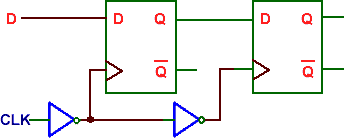

Normally we use a decimal counting system meaning each digit in a number is represented by one of 10 characters (0-9). The most important is the fact that since the outputs of a digital chip can only be in one of two states, it must use a different counting system than you are accustomed to. BINARY COUNTER Before starting with counters there is some vital information that needs to be understood.
When a logic state changes from a zero to a one the voltage at the pin in question goes from zero volts to +5 volts. What we call logic 1 is +5 volts. What we call logic 0 to a computer is zero volts. It only works on voltage changes. A computer does not recognize 0 or 1.
Gets above 9, we set it to 0 and add one to the next digit over. When that digit overflows, i.e. When counting up in a decimal system, we start with the first digit.
The diagram also shows that eight bits make up what is called a byte. In the example below, we find that the binary number is equal to 183. All you need to do to convert from binary to decimal is add up the applicable powers of 2. Each digit, or bit of the binary number represents a power of two. DECIMAL TO BINARY CONVERSION Decimal Number (base 10) Binary Number (base 2) BINARY COUNTING To convert a binary number to a decimal, we use a simple system. When the count goes above 1 we add one to the next digit over and set the first digit to 0.
This register uses D flip-flops, so it’s easy to store data without worrying about flip-flop input equations. The deviceinputs are compatible with standard CMOS outputs with pullupresistors, they are compatible with LS/ALSTTL outputs.This device consists of eight D flip-flops with common Clock and datasheet search, A 4-bit register from LogicWorks, Reg-4, is on the right, and its internal implementation is below. Referring to nibbles and bytes are useful when dealing with other number systems such as hexadecimal, which is base 16.SL74HC273System LogicSemiconductorSLSOctal D Flip-Flop with Common Clock and ResetHigh-Performance Silicon-Gate CMOSThe SL74HC273 is identical in pinout to the LS/ALS273.
The data sheet used is for an MC14161 counter from Motorola. It may either not be there at all, i.e., or it could have been made with Lower Power Schottky characteristics and be designated 74LS161. 2 Byte Upper Nibble Lower Nibble Binary number = 183 The counter you will use in lab is the 74XX161, the XX determines what technology was implemented when the chip was built. JRegisters and counters 4.
Functional diagram mna418 RD FF SD 4 10 Q 1Q 2Q 1Q 2Q 5 9 2 12 3 11 6 8 Q 1SD CP 2CP 1CP 2D 1D D 2SD 1 13 1RD 2RD Fig. Be sure to hook up the pins correctly on the actual circuit.Dual D-type flip-flop with set and reset positive edge-trigger 4. This is a common practice to keep the schematic as neat as possible. First, the pins on the chip diagram are not presented in their actual order.
Pins P1 through P4 are the program input pins. A ip-op is triggered by a clock signal edge.3 PIN OUT DETAILS QA-QD P1-P4 CLK CO TE, PE CL LD = Outputs = Program Input = Clock = Carry out = Counter and program enable = Clear (Master Reset) = Load P1-P4 value onto QA-QD The binary outputs are located at pins Q1 through Q4. Although the terminology varies somewhat in the literature, it is generally agreed that (see Figure 5.15.): A latch uses a level based clock signal. IEC logic symbol RD FF SD 4 Q 1Q 1Q 2 5 3 Q 6 1SD CP 1CP 1D D 1 1RD mna420 RD FF.
The TE pin, counter enable, when high, + 5 volts, enables the counter to increment with every positive clock pulse. This means that when the clock signal goes from zero volts to +5 volts, the counter increments by one. The clock input, CLK, is an active high input.
When the signal at the clear pin goes from +5 volts to zero volts, all the outputs, Q1-Q4, will go low, zero volts, regardless of the count or data on pins P1-P4. The circle before the connection indicated active low. The clear pin, CL, is also an active low pin. This means that when the signal on the LD pin goes from a low to a high, 0V to +5V, the data at P1-P4 is transferred to Q1-Q4. The bar above the LD designation means active low. The load pin, LD, is active low.
Observing the input signal, the clock signal on the MC14161, when it goes low the Q 0 output changes state. Q 0 is dependent on the input signal, Q 1 is dependent on Q 0, Q 2 is dependent on Q 1. Each of the outputs is either dependent on the state of the input or the previous output. The diagram above shows that when the input signal goes low then the outputs change state as required.
It is also important to note that since the outputs change only after every two clock pulses, the outputs are successively one-half the frequency of the previous output. Since Q 0 was high and now has gone low, Q 1 senses this negative transition and then goes high. Note that Q 0 stays at its high state until the next negative transition of the clock signal. The remaining outputs stay at the same state. When the first negative transition of the clock signal occurs, Q 0 goes from low to high.



 0 kommentar(er)
0 kommentar(er)
